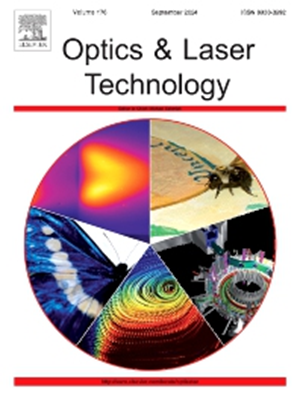宽带高效偏振无关光子自旋霍尔效应,对所有入射角具有高结构容限
IF 4.6
2区 物理与天体物理
Q1 OPTICS
引用次数: 0
摘要
光子自旋霍尔效应(PSHE)表现为光在光学界面上的自旋分离,表现出对入射偏振和入射角的敏感性。在这项研究中,我们证明了PSHE在平面偏振入射波的所有入射角上都实现了偏振不敏感。通过水平偏振光(H)和垂直偏振光(V)的数值计算,我们观察到半球面棱镜耦合Ag-SiO2-Ag基MIM结构反射光的自旋分离等量级δ±H=δ±V。此外,我们的研究表明,尽管物理尺寸发生了变化,但偏振无关的PSHE仍然保持不变,突出了其坚固性和对结构修改或制造缺陷的高容忍度。此外,所提出的PSHE的效率也显示出从~ 80%到接近100%的高值。这种增强的效率对于现实世界的实现至关重要,因为它可以开发具有改进性能和可靠性的先进光子器件。此外,光谱分析表明,在400nm至1400nm的整个宽带范围内,PI-PSHE行为始终保持不变。该研究为开发具有极化和入射角不敏感、高效率和高结构公差的自旋光器件提供了一条途径,在各种应用中有很大的发展前景。本文章由计算机程序翻译,如有差异,请以英文原文为准。
Broadband high-efficiency polarization-independent Photonic Spin Hall Effect with high structure tolerance for all incident angle
The Photonic Spin Hall Effect (PSHE) manifests as the spin separation of light at an optical interface, exhibiting sensitivity to incident polarization and incident angles. In this study, we demonstrate the attainment of polarization insensitivity of PSHE across all incident angles for a plane-polarized incident wave. Through numerical calculation with horizontally (H) and vertically (V) polarized light, we observe equal magnitude spin separation in the reflected light from a hemispherical prism-coupled Ag-SiO2-Ag, based MIM structure. Moreover, our investigation reveals that despite alterations in physical dimensions, the polarization-independent PSHE is preserved, highlighting its robustness and high tolerance to structural modification or fabrication defects. Further the efficiency of presented PSHE is also showing a high value ranging from ∼ 80 % to near 100 %. This enhanced efficiency is crucial for real-world implementations, as it enables the development of advanced photonic devices with improved performance and reliability. Furthermore, the spectral analysis reveals that the PI-PSHE behavior is consistently preserved across the entire broadband range from 400 nm to 1400 nm. This research presents an avenue for developing spin optic devices with polarization and incident angle insensitivity, coupled with large efficiency and high structural tolerance, promising advancements in various applications.
求助全文
通过发布文献求助,成功后即可免费获取论文全文。
去求助
来源期刊
CiteScore
8.50
自引率
10.00%
发文量
1060
审稿时长
3.4 months
期刊介绍:
Optics & Laser Technology aims to provide a vehicle for the publication of a broad range of high quality research and review papers in those fields of scientific and engineering research appertaining to the development and application of the technology of optics and lasers. Papers describing original work in these areas are submitted to rigorous refereeing prior to acceptance for publication.
The scope of Optics & Laser Technology encompasses, but is not restricted to, the following areas:
•development in all types of lasers
•developments in optoelectronic devices and photonics
•developments in new photonics and optical concepts
•developments in conventional optics, optical instruments and components
•techniques of optical metrology, including interferometry and optical fibre sensors
•LIDAR and other non-contact optical measurement techniques, including optical methods in heat and fluid flow
•applications of lasers to materials processing, optical NDT display (including holography) and optical communication
•research and development in the field of laser safety including studies of hazards resulting from the applications of lasers (laser safety, hazards of laser fume)
•developments in optical computing and optical information processing
•developments in new optical materials
•developments in new optical characterization methods and techniques
•developments in quantum optics
•developments in light assisted micro and nanofabrication methods and techniques
•developments in nanophotonics and biophotonics
•developments in imaging processing and systems

 求助内容:
求助内容: 应助结果提醒方式:
应助结果提醒方式:


